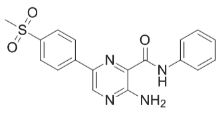All AbMole products are for research use only, cannot be used for human consumption.

VE-821 is a novel ATR inhibitor. VE-821 was shown to inhibit ATR-mediated signalling in response to replication arrest induced by severe hypoxia. VE-821 inhibited radiation- and gemcitabine-induced phosphorylation of Chk1, confirming inhibition of ATR signaling. ATR inhibition by VE-821 led to inhibition of radiation-induced G 2/M arrest in cancer cells. Consistently, VE-821 significantly enhanced the sensitivity of PSN-1, MiaPaCa-2 and primary PancM pancreatic cancer cells to radiation and gemcitabine under both normoxic and hypoxic conditions. VE-821 induced DNA damage and consequently increased Ataxia Telangiectasia Mutated-mediated phosphorylation of H2AX and KAP1. Most importantly, VE-821 increased radiation-induced loss of viability in hypoxic conditions. Reduced cancer cell radiosurvival following treatment with VE-821 was also accompanied by increased DNA damage and inhibition of homologous recombination repair, as evidenced by persistence of γH2AX and 53BP1 foci and inhibition of Rad51 foci, respectively.
| Cell Experiment | |
|---|---|
| Cell lines | MiaPaCa-2, PSN-1 and Panc1 cells |
| Preparation method | Cell viability assays MiaPaCa-2, PSN-1 and Panc1 (5 x 104) were plated in 96-well plates and after 4 h treated with increasing concentrations of VE-821 at 1 h before irradiation with a single dose of 4 Gy. Medium was replaced 72 h post-irradiation at which point viability was measured using the using the Alamar Blue assay (Resazurin substrate, M10350). Cells were allowed to proliferate and cell viability was again analyzed at day 10 for the different treatment conditions. Cell viability and surviving fraction were normalized to the untreated (control) group. |
| Concentrations | 0~9µM |
| Incubation time | 72h |
| Animal Experiment | |
|---|---|
| Animal models | mice bearing PSN-1 xenografts |
| Formulation | 10% Vitamin E d-alpha tocopheryl polyethylene glycol 1000 succinate and administered by gavage, in 200 μl. |
| Dosages | 60 mg/Kg on days 0 and 1 |
| Administration | oral gavage |
| Molecular Weight | 368.41 |
| Formula | C18H16N4O3S |
| CAS Number | 1232410-49-9 |
| Solubility (25°C) | DMSO 60 mg/mL |
| Storage |
Powder -20°C 3 years ; 4°C 2 years In solvent -80°C 6 months ; -20°C 1 month |
| Related ATM/ATR Products |
|---|
| ART0380
ART0380 is a potent and selective ATR kinase inhibitor. |
| KU 59403
KU 59403 is a potent ATM inhibitor, with IC50 values of 3 nM, 9.1 μM and 10 μM for ATM, DNA-PK and PI3K, respectively. |
| SKLB-197
SKLB-197 showed an IC50 value of 0.013 μM against ATR but very weak or no activity against other 402 protein kinases. |
| ATR-IN-4
ATR-IN-4 is a potent ATR (Ataxia telangiectasia mutated gene Rad 3-associated kinase) inhibitor. |
| M3541
M3541 is a potent, ATP-competitive and selective ATM inhibitor with an IC50 of 0.25 nM. |
All AbMole products are for research use only, cannot be used for human consumption or veterinary use. We do not provide products or services to individuals. Please comply with the intended use and do not use AbMole products for any other purpose.


Products are for research use only. Not for human use. We do not sell to patients.
© Copyright 2010-2024 AbMole BioScience. All Rights Reserved.
